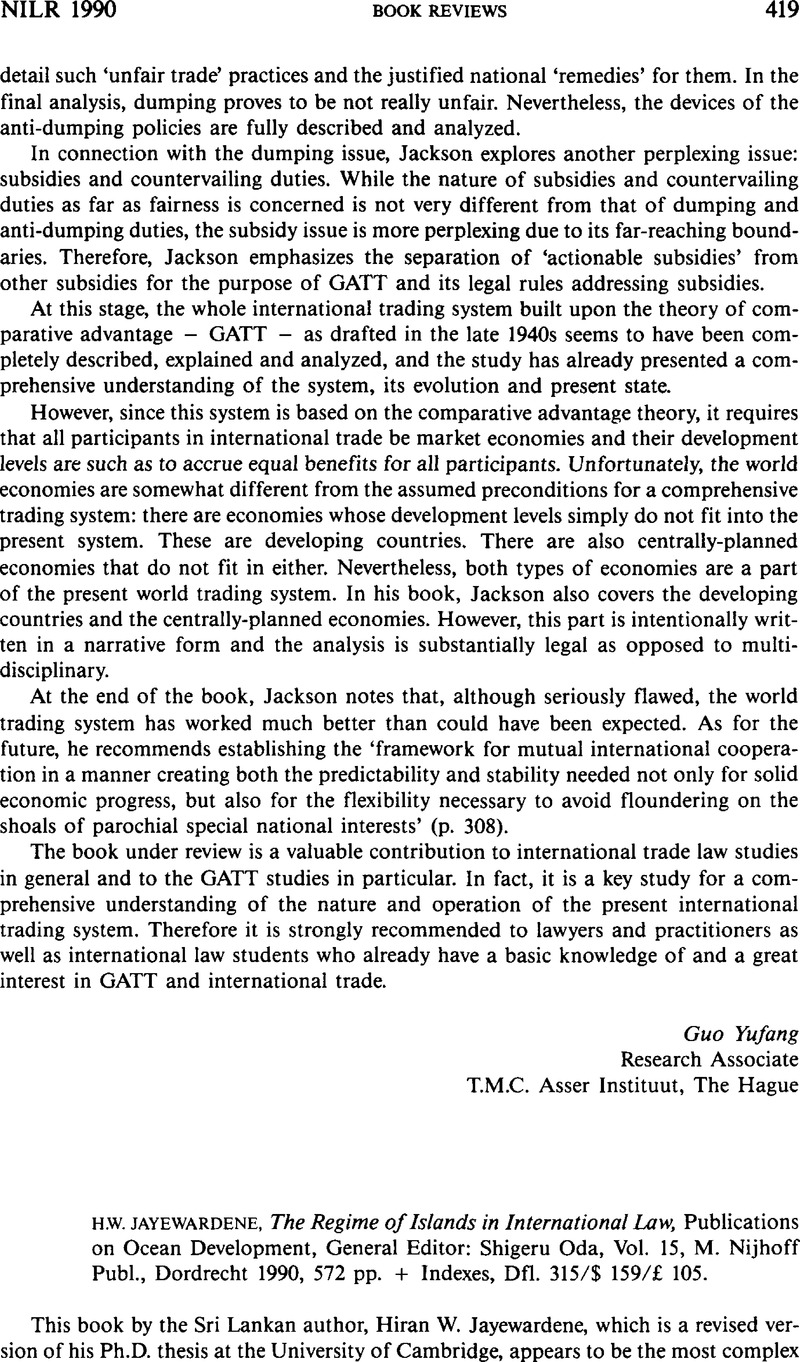No CrossRef data available.
Article contents
H.W. Jayewardene, The Regime of Islands in International Law, Publications on Ocean Development, General Editor: Shigeru Oda, Vol. 15, M. Nijhoff Publ., Dordrecht1990, 572 pp. + Indexes, Dfl. 315/$ 159/£ 105.
Published online by Cambridge University Press: 21 May 2009
Abstract

- Type
- Book Reviews
- Information
- Copyright
- Copyright © T.M.C. Asser Press 1990
References
1. This in fact can also be advantageous with respect to many problems other than islands, as illustrated by, e.g., the special recognition gained by Ambassador Jayewardene during UNCLOS III for Sri Lankan (and likewise Indian) sovereignty over an unique extent of its continental shelf on the basis of geological evidence which he collected at that time (p. 571). This recognition is enshrined in UNCLOS III Final Act's Annex II containing the Statement of Understanding Concerning a Specific Method to be Used in Establishing the Outer Edge of the Continental Margin and applying exclusively to the southern part of the Bay of Bengal, although in practice a similar situation could also be claimed by States other than Sri Lanka and India.
2. By 3 May 1990, the LOS Convention had obtained 159 signatures and 43 (out of the 60 required for its entry into force) ratifications. See 15 Law of the Sea Bulletin (UN Office for Ocean Affairs and the Law of the Sea) (05 1990) pp. 1–6Google Scholar. Note also the relevant studies issued by this UN Office on island-related questions, such as: Regime of Islands (United Nations, 1988)Google Scholar; Baselines (United Nations, 1989)Google Scholar; and Archipelagic States (United Nations, 1990)Google Scholar.
3. For an excellent brief exposition of this regime, see the article by one of the principal architects thereof, Kusumaatmadja, M., “The Concept of the Indonesian Archipelago”, 10 Indonesian Q. (1982) no. 4, pp. 12–26Google Scholar. For an extensive analysis of State practice, see also Kwiatkowska, B. and Agoes, E.R., ‘Archipelagic Waters: An Assessment of National Legislation’, in Wolfrum, R., ed., Law of the Sea at the Crossroads: The Continuing Search for a Universally Accepted Regime, Proceedings of International Symposium Held in Kiel, on 10–14 July 1990 (forthcoming)Google Scholar.
4. Cf., Bowett, D.W., ‘The Economic Factor in Maritime Delimitation Cases’, in International Law at the Time of its Codification – Essays in Honour of Roberto Ago, Vol. II (1987) pp. 45–63Google Scholar.
5. Note that while discussing the 1978 Netherlands (Antilles)-Venezuela delimitation agreement, the Dutch author, Soons, maintains that more equitable than full effect would be if Aves, having only the 12 mile territorial sea, would form an enclave within the exclusive economic zones of neighbouring islands. See Soons, A.H.A., ‘De Nederlandse Antillen en het recht van de zee – Commentaar’ (The Netherlands Antilles and the Law of the Sea – A Commentary), in Meijers, H., ed., Volkenrechtelijke aspekten van Antilliaanse onafhankelijkheid (1980) pp. 269, 279Google Scholar.




